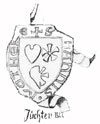The Juchter-Seal from 1344
 |
The seal of the Johannis Juchtere (from wax), hangs on a pergament, which was marked on 31 October 1344. (MCCCXL quarto in vigilia omnius sanctorum) Count Konrad I of Oldenburg records a contract between the monastery Blankenburg (6 km removed from the city Oldenburg) and Elert Wulf, which transferred the goods of the monastery to Lynerbrook to management. Elert Wulf and three defiency guarantees seal after the count Konrad. The three witnesses are: Johannis Juchtere, Florentius Kust and Reyners son Hermann of Lynerbrook. Wulfs seal today unfortunately does not hang no more on the document. It is the time to the victim
pleases.
|
|
615 years outlasted the
Juchterseal. Old documents and seals are like bridges into the
past. They connect directly with our ancestors. Everyone get a sentimental
feeling, who regards the document, which held our name carrier in the hands six centuries ago and provided it with his
seal. In the family file to Oldenburg everyone can look at this oldest document of
theJuechter/Juchter family.
From the Juchterseal on dark wax is aborted the right upper corner with the two letters JO. Everything else is kept good. The transcription shows
clearly: -- HANNIS JUCHTERE. The split coat of arms with the five-leafs representative rose and the sea-leafs steps clearly out. The inscription of the seal casting
reads: +S.(igillum) Johannis Jucthere. I.e. seals of the Johann
Juchter. Therefore the way of writing of the name was in former times very arbitrary and varied in the course of the
centuries. The cross at the start of the transcription was in the Christian Middle Ages a popular initialization character and meant a calling of the name Christi. The unusual letter form is the today rare Unziale, which was however the rule in the Middle
Ages.
|
|
|